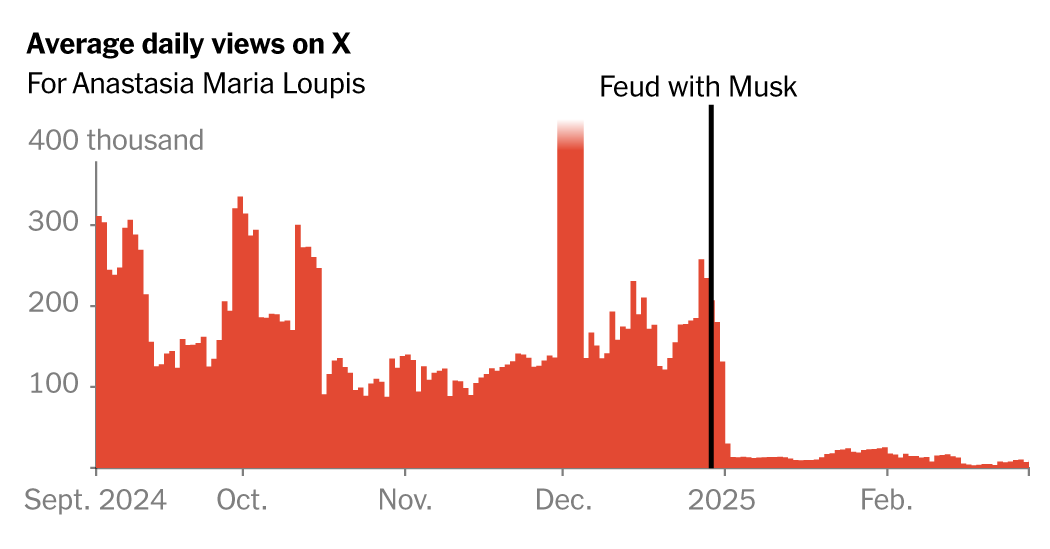When Mr. Musk purchased X in 2022, he promised to create a free speech haven and named himself a “free speech absolutist.”
Critics still feared that Mr. Musk would use his control of the app to pick and choose his favorites, amplifying voices he admired while suppressing people or topics he loathed.
The New York Times found three users on X who feuded with Mr. Musk in December only to see their reach on the social platform practically vanish overnight. The accounts are the starkest signs yet that Mr. Musk or others at the company have the power to punish critics and that they may be willing to use it, startling free speech advocates who hoped that the billionaire would be their champion.
Concerns about Mr. Musk’s influence have grown alongside his political ambitions as one of President Trump’s closest allies. He has also set his sights on boosting far-right politics across the world.
“This is working against the type of environment that he claimed he wanted to build,” said Ari Cohn, the lead counsel for technology policy at the Foundation for Individual Rights and Expression, a free speech advocacy group. “Don’t sit here and cloak yourself in the First Amendment and free speech, and then do things like that.”
It is not clear what precisely happened to the three accounts that feuded with Mr. Musk in late December. Dozens of other users also said their accounts were impacted after criticizing the billionaire, but The Times reviewed data for those accounts and did not find clear evidence that their visibility was severely impacted. As with any social network, the algorithms that control a post’s distribution — and the data that fuels those decisions — are impossible for outsiders to scrutinize.
Mr. Musk has offered several clues to what happened, writing on X amid the feud that if powerful accounts blocked or muted others, their reach would be sharply limited. (Mr. Musk is the most popular user on X with more than 219 million followers, so his actions to block or mute users could hold significant sway.) He also suggested that he might have kicked some users off X’s premium program, which boosts the visibility of paying subscribers. Doing so would effectively curtail their reach and prevent them from making money on X.
Mr. Musk and X did not respond to requests for comments. In a page about its moderation policies, the company wrote that it had several tools to limit the visibility of posts or users, but that it “does not block, limit, or remove content based on an individual’s views or opinions.”
Like Ms. Loupis, Laura Loomer is used to picking fights on X as a far-right influencer who has gained over a million followers spreading falsehoods, conspiracy theories and racism, branding herself as an unflinching ally of Mr. Trump. But things changed when she turned her sights on Mr. Musk in December, writing that he was “exposed” over his support for the visa programs.
“Loomer is looking for attention,” Mr. Musk wrote about her. “Ignore.”
Almost immediately, her reach on the platform dropped. It stayed that way for weeks until her posts started gaining traction again — just as Mr. Musk started interacting with her posts once more.
Ms. Loomer also briefly lost access to X Premium after feuding with Mr. Musk, which might have explained the declining popularity of her posts. But a Times analysis found no clear relationship between the popularity of her posts and when she was removed from and reinstated to the program.
“Thank you very much @elonmusk for giving me back my monetization tonight,” she wrote on X in February.
“You’re welcome,” Mr. Musk replied.
When Ms. Loomer lost her access to X Premium, she also lost the ability to earn money from her paid subscribers and from X’s revenue program, which shares ad dollars with premium users. She estimated in an interview that she lost about $50,000 from X during the period when her account was suppressed.
“I think it’s wrong to say it’s a free speech platform and then shut off people’s ability to monetize,” Ms. Loomer said.
Ms. Loupis and Ms. Loomer contributed to a torrent of criticism against Mr. Musk over his position on visas for skilled workers. Many Trump supporters with anti-immigrant views want such programs shuttered, while Mr. Musk and other tech leaders support them.
While views on Ms. Loomer’s posts returned to their previous highs, Ms. Loupis opened a second account on X in a bid to circumvent any suppression against her. Despite having a fraction of the followers, posts on her new account are getting more views than those posted to her original account. She wrote in January that she planned to sue Mr. Musk and X.
“It has turned out to be all lies from him,” said Ms. Loupis in an interview from Denmark. “It’s disappointing because we supported him and believed in him very, very much.”
Mr. Musk has been accused of abusing his control over X before, though not in this exact way. A group of prominent journalists were suddenly suspended in 2022. Mr. Musk suggested at the time that they had violated the site’s privacy rules by posting personal information, but did not elaborate. Their accounts were later reinstated without explanation.
The third user The Times identified was Owen Shroyer, a far-right activist and host of a show on Infowars, the streaming platform home to many conspiracy theorists. He joined the feud about visas on Dec. 26, mocking jobs provided to visa holders. His reach has been down since. Like Ms. Loomer, Mr. Shroyer briefly lost access to X Premium.
Mr. Shroyer found that his followers would see his posts if they were online when he posted them. But if they logged in later, they would never see them in their feeds.
“My theory is that someone is manipulating reach based off of personal, political or issue based bias,” Mr. Shroyer said in an email, adding that X has provided no explanation.
Mr. Shroyer stopped short of blaming Mr. Musk directly, writing instead that “some of the powers he has delegated could be being abused.”
X offers few tools to monitor the social network, and Mr. Musk has disabled some features that had allowed researchers to monitor changes on the platform. To identify these three accounts, The Times used a service that collects data from X to analyze views for dozens of users involved in various feuds with Mr. Musk for changes in their daily impressions.
Many others who criticized Mr. Musk have claimed they were quietly suppressed on the platform, a tactic known as shadowbanning or ghost banning. Though The Times did not identify other accounts that were artificially suppressed, such changes would be difficult to spot if users did not post frequently, or did not have many popular posts.
“If he did it to small accounts, nobody would notice,” said Ms. Loupis, who has more than one million followers on her original account. “But when he starts doing it to really, really big influencers with millions of followers, everybody notices.”
Before Mr. Musk bought the platform in 2022, when it was known as Twitter, many right-wing users had criticized the company for shadowbanning. Mr. Musk wrote in November last year that “there is no shadowbanning anymore.” At the same time, he has said that he believes in “freedom of speech, not freedom of reach,” meaning that the platform would not bar people for hateful content but would make it harder to find such content.
“There will always be critics,” Mr. Musk wrote in February last year. “What is perhaps notable is that I don’t attempt to silence them even on a platform that I own.”









